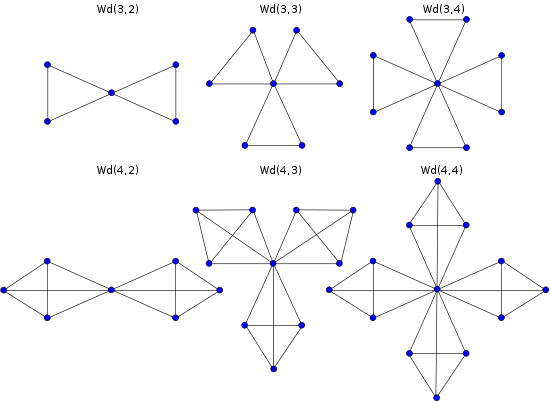Windmill graph
In the mathematical field of graph theory, the windmill graph Wd(k,n) is an undirected graph constructed for k ≥ 2 and n ≥ 2 by joining n copies of the complete graph Kk at a shared universal vertex. That is, it is a 1-clique-sum of these complete graphs.[1]
| Windmill graph | |
|---|---|
.svg.png) The Windmill graph Wd(5,4). | |
| Vertices | (k-1)n+1 |
| Edges | nk(k−1)/2 |
| Radius | 1 |
| Diameter | 2 |
| Girth | 3 if k > 2 |
| Chromatic number | k |
| Chromatic index | n(k-1) |
| Notation | Wd(k,n) |
| Table of graphs and parameters | |
Properties
It has (k-1)n+1 vertices and nk(k−1)/2 edges,[2] girth 3 (if k > 2), radius 1 and diameter 2. It has vertex connectivity 1 because its central vertex is an articulation point; however, like the complete graphs from which it is formed, it is (k-1)-edge-connected. It is trivially perfect and a block graph.
Special cases
By construction, the windmill graph Wd(3,n) is the friendship graph Fn, the windmill graph Wd(2,n) is the star graph Sn and the windmill graph Wd(3,2) is the butterfly graph.
Labeling and colouring
The windmill graph has chromatic number k and chromatic index n(k-1). Its chromatic polynomial can be deduced form the chromatic polynomial of the complete graph and is equal to
The windmill graph Wd(k,n) is proved not graceful if k > 5.[3] In 1979, Bermond has conjectured that Wd(4,n) is graceful for all n ≥ 4.[4] Through an equivalence with perfect difference families, this has been proved for n ≤ 1000. [5] Bermond, Kotzig, and Turgeon proved that Wd(k,n) is not graceful when k = 4 and n = 2 or n = 3, and when k = 5 and m = 2.[6] The windmill Wd(3,n) is graceful if and only if n ≡ 0 (mod 4) or n ≡ 1 (mod 4).[7]
Gallery

References
- Gallian, J. A. (3 January 2007). "Dynamic Survey DS6: Graph Labeling" (PDF). Electronic Journal of Combinatorics. DS6: 1–58.
- Weisstein, Eric W. "Windmill Graph". MathWorld.
- Koh, K. M.; Rogers, D. G.; Teo, H. K.; Yap, K. Y. (1980). "Graceful graphs: some further results and problems". Congr. Numer. 29: 559–571.
- Bermond, J.C. (1979). "Graceful graphs, radio antennae and French windmills". In Wilson, Robin J. (ed.). Graph theory and combinatorics. Research notes in mathematics. 34. Pitman. pp. 18–37. ISBN 978-0273084358. OCLC 757210583.
- Ge, G.; Miao, Y.; Sun, X. (2010). "Perfect difference families, perfect difference matrices, and related combinatorial structures". Journal of Combinatorial Designs. 18 (6): 415–449. doi:10.1002/jcd.20259.
- Bermond, J. C.; Kotzig, A.; Turgeon, J. (1978). "On a combinatorial problem of antennas in radioastronomy". In Hajnal, A.; Sos, Vera T. (eds.). Combinatorics. Colloquia mathematica Societatis János Bolyai. 18. North-Holland. pp. 135–149. ISBN 978-0-444-85095-9.
- Bermond, J.C.; Brouwer, A. E.; Germa, A. (1978). "Systèmes de triplets et différences associées". Problèmes combinatoires et théorie des graphes: Orsay 9-13 Juillet 1976. Colloques internationaux du Centre National de la Recherche Scientifique. 260. Éditions du Centre national de la recherche scientifique. pp. 35–38. ISBN 978-2-222-02070-7.